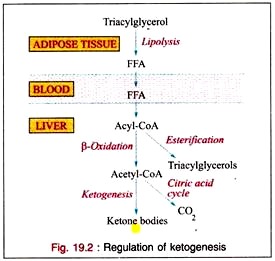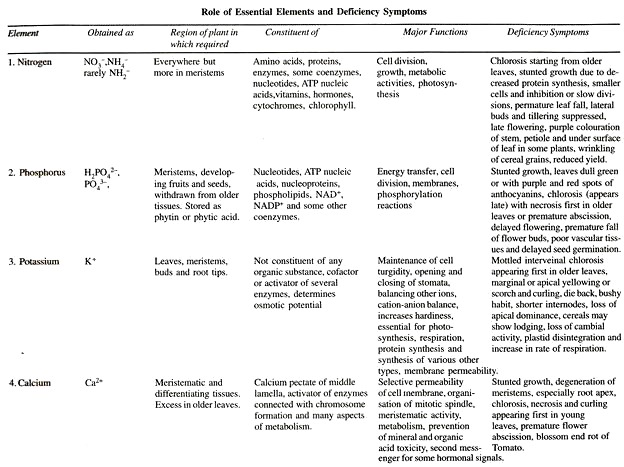ADVERTISEMENTS:
In this essay we will discuss about:- 1. Subject-Matter of Essential Mineral Elements 2. Criteria of Essential Mineral Element 3. Types 4. Mineral and Non-Mineral Elements 5. Deficiency Symptoms.
Contents:
- Essay on the Subject-Matter of Essential Mineral Elements
- Essay on the Criteria of Essential Mineral Elements
- Essay on the Types of Essential Mineral Elements
- Essay on the Mineral and Non-Mineral Elements
- Essay on the Deficiency Symptoms of Essential Mineral Elements
Essay # 1. Subject-Matter of Essential Mineral Elements:
ADVERTISEMENTS:
Most of the minerals present in the soil can enter plants. With the help of sensitive techniques, concentration as low as 10-8 g/ml can be detected. More than sixty minerals present in soil have been recorded in plants. Some plants accumulate heavy and toxic materials, e.g., Astragalus (selenium), Phacelia sericea (gold), plants growing near nuclear sites (radioactive strontium).
All the elements found in plants are not essential for plants. Similarly, all elements essential for animal growth are not required by plants. The most important of them are iodine and sodium. An essential element is the one which has a specific structural or physiological role and without which plants cannot complete their life cycle.
Essay # 2. Criteria of Essential Mineral Element:
Amon and Stout (1939) proposed criteria for knowing the essentiality of an element.
ADVERTISEMENTS:
They are:
1. It is indispensable for the growth of plants.
2. The element is directly involved in the metabolism of plants. It becomes a component of either a structural or functional molecule. The element may additionally have a corrective effect on mineral balance and other soil conditions.
3. A plant is unable to complete its vegetative or reproductive phase in the absence of the element.
4. The element cannot be replaced by any other element.
5. The absence or deficiency of the element produces disorders. These disorders are a direct result of the lack or deficiency of the element.
6. The element alone can correct the disorders produced by its absence or deficiency.
17 elements have been found to be essential. They are С, H, O, N, P, K, S, Mg, Ca, Fe, B, Mn, Cu, Zn, Mo, Cl and Ni. Others are called nonessential elements. However, some of the nonessential elements have been found to be required in metabolic activities of certain plants. They include cobalt, silicon, sodium, vanadium, aluminum, etc. Silicon is required by most grasses and cereals.
Its deficiency produces leaf necrosis and stunted growth in Rice. Sodium seems to be involved in membrane permeability though its essentiality has not been proved. These elements are called functional elements or non- essential functional or beneficial elements.
ADVERTISEMENTS:
Essay # 3. Types of Essential Mineral Element:
ADVERTISEMENTS:
Essential elements occur in different proportions (Table 12.1) in the plants. They are differentiated into two categories, macro-elements and microelements. The terms major, minor and trace elements are generally reserved for elements involved in animal nutrition.
 (i) Macro-elements (Macronutrients):
(i) Macro-elements (Macronutrients):
They are those essential elements which are present in easily detectable quantities, 1-10 mg per gram of dry matter. Macro-elements are usually involved in the synthesis of organic molecules and development of osmotic potential.
ADVERTISEMENTS:
They are nine in number— С, H, 0, N, P, K, S, Mg and Ca. 96% of the dry matter is formed of carbon, hydrogen and oxygen. On fresh weight basis, oxygen is the most abundant element in plant body as well as other organisms. On dry weight basis, it is almost as abundant as carbon. Of the nonessential functional or beneficial elements, silicon and sodium often occur in the range of macro-elements.
Iron occurs in the concentration of less than 1 mg/gm. However, its essentiality was discovered along with other macro-elements long before microelements were found to be required. Therefore, it is often regarded to be macro-element.
(ii) Microelements (Micronutrients):
ADVERTISEMENTS:
They are those essential elements which are required by plants in small amounts, equal or less than 0.1 mg/gm. of dry matter. Their essentiality came to be known only when extra pure salts were used in culture experiments.
Microelements are mostly involved in the functioning of enzymes, as cofactors or metal activators. They are eight in number — Fe, Zn, Mn, B, Cu, Mo, Cl and Ni. Nonessential functional or beneficial elements which belong to the category of microelements are cobalt, vanadium and aluminum.
Essay # 4. Mineral and Non-Mineral Elements:
Essential elements derived from soil are termed as mineral elements. Essential elements got from air or water are known as non-mineral elements, e.g., С, H, O. They are building blocks of macromolecules that form the bulk of plant body.
ADVERTISEMENTS:
In aquatic habitats as well as in soil solution, mineral elements occur dissolved in water. Carbon is mostly got from air as CO2. Hydrogen is obtained from water. Oxygen is a component of water.
It is also available from air. Nitrogen is present in abundance in the air as a non-mineral element but plants usually obtain it from soil as nitrate or ammonium ion. The two are formed by the process of fixation of atmospheric nitrogen though a small quantity can also come from weathering of rocks.
Chlorine is not as a mineral from soil but can also be obtained from the atmosphere. Similarly, some sulphur is also absorbed from the atmosphere where it is present as a pollutant in the gaseous state of sulphur dioxide.
Mineral Elements:
P, K, S, Mg, Ca, Fe, Zn, Mn, B, Cu, Mo, Cl and N.
Non-Mineral Elements:
ADVERTISEMENTS:
С, О, H and N.
ADVERTISEMENTS:
Essay # 5. Deficiency Symptoms of Essential Mineral Elements:
Deficiency symptoms are externally visible pathological conditions (morphological and physiological deformities or abnormalities) which are produced due to absence or deficiency of some essential nutritive substance. Deficiency symptoms are also called hunger signs.
They appear when the availability of the essential nutrients falls below the critical concentration. Critical concentration is that limited concentration of the essential element below which growth of the plant is reduced. As each essential element has one or more specific structural and functional roles, its deficient supply results in appearance of abnormal signs called deficiency symptoms.
The symptoms disappear when the deficient element is supplied. Deficiency symptoms appear first in young leaves and young tissues for elements which are relatively immobile inside the plant, e.g., Ca, S. They appear first in old leaves and tissues for those elements which are mobilised from senescing regions for supply to young tissues.
Knowledge of deficiency symptoms in relation to particular elements help the farmer and the farm scientist to recognise the same when they are present in a field or area. Immediate corrective measure can then be taken by supplying the missing or deficient nutrient to the soil or directly spraying it over the crop.
Deficiency symptoms are first studied by means of pot and culture experiments. Rapidly growing plants which develop characteristic symptoms are used in culture experiments. They are called test (= indicator) plants. They are then grown in soil under test in small pots.
The results are compared to know the deficiency elements. Similar tests are performed with selected crops. Excess of minerals are often toxic. The toxicity is studied first in culture experiments and then field or soil trials.
Common Deficiency Symptoms:
(1) Chlorosis:
Non-development or loss of chlorophyll. N, K, Mg, S, Fe, Mn, Zn, Mo.
(2) Stunted Growth:
N, K, Ca, S, Zn, B, Mo, Cl.
(3) Purple Colouration of Shoot Axis or Leaves:
N, P, Mg, S, Mo.
(4) Necrosis:
Death of tissues. Ca, Mg, Сu, K.
(5) Premature Fall of Leaves and Buds:
P, Mg, Cu.
(6) Inhibition of Cell Division:
N, K, S, Mo.
(7) Wrinkling of Cereal Grains:
N, S, Mo.
(8) Dormancy of Lateral Buds:
N, S, Mo.
(9) Late Flowering:
N, S, Mo.
(10) Die Back:
ADVERTISEMENTS:
Killing of shoot apex (stem tip and young leaves). K, Cu.
(11) Wilting. Loss of turgor. Cl.
(12) Death of Root and Shoot Tips. B.
(13) Bushy Habit of Shoot. K.
(14) Scorched Leaf Tips. K.
(15) Interveinal Chlorosis. Fe.
(16) Whiptail Disease of Leaves. Mo.
Toxicity of Micronutrients:
In higher doses, micronutrients become toxic. Any tissue concentration which reduces dry weight of tissue by 10% is called toxic concentration. Critical toxic concentration is different for different micronutrients as well as different plants.
For example, Mn2+ is toxic beyond 600 µg g-1 for Soya-bean and beyond 5300 µg g-1 for Sunflower. Toxic effects may be due to direct excess of the micronutrient or its interference in the absorption and functioning of other nutrients.
Manganese toxicity (brown spots surrounded by chlorotic veins) is due to:
(i) Reduction in uptake of iron and magnesium,
(ii) Inhibition of binding of Magnesium to specific enzymes,
(iii) Inhibition of Calcium translocation into shoot apex.
Therefore, excess of Manganese causes deficiency of Iron, Magnesium and Calcium. The toxicity symptoms of Mn are actually combined deficiency symptoms of Fe, Mg and Ca.





